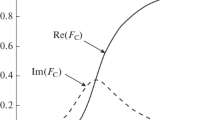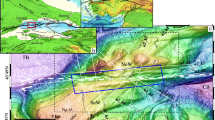Abstract
Many shallow water, fine-grained sediments are almost acoustically impenetrable to the energy from high resolution, low energy continuous seismic profilers. It has been alleged that this anomalous acoustic behavior is the result of interstitial gas bubbles that produce reverberation within the sediment, but no analyses were made until recently to test this hypothesis. Determinations of the compressibility of sediments from acoustically impenetrable, or turbid, zones and from contiguous zones of good penetration in Chesapeake Bay showed that the acoustically turbid sediments are several orders of magnitude more compressible than acoustically clear sediments of very similar grain size. The increased compressibility is a result of the presence of interstitial gas bubbles. Other acoustically turbid zones are produced by buried shell beds, and do not show an increase in compressibility.
Similar content being viewed by others
References
EmeryK. O.: 1969, A Coastal Pond Studied by Oceanographic Methods, Elsevier Publ. Co., New York, 80 p.
GrimM. S., DrakeC. L., and HeirtzlerJ. R.: 1970, ‘Sub-Bottom Study of Long Island Sound’, Bull. Geol. Soc. Amer. 81, 649–666.
KleinM. and EdgertonH. E.: 1968, ‘Sonar—A Modern Technique for Ocean Exploration’, Inst. Elect. Electron. Eng. Spectrum 5, 40–46.
SchubelJ. R.: 1968, ‘Turbidity Maximum of Northern Chesapeake Bay’, Science 161, 1013–1015.
SkemptonA. W.: 1961, ‘Effective Stress in Soils, Concrete, and Rocks’, in International Society of Soil Mechanics and Foundation Engineering, British Nat. Soc., Pore Pressure and Suction in Soils. Butterworths, London.
Stiles, N. T.: 1970, ‘Isopachous Mapping of the Lower Patuxent Estuary Sediments by Continuous Seismic Profiling Techniques’, U.S. Naval Oceanographic Office Informal Report No. 37, 26 p.
StilesN. T., BreslauL. R., and BeestonM. D.: 1969, ‘The Riverbed Roughness and Sub-Bottom Structure of the Main Shipping Channel to Sai Gon, RVN (Nga Bay, Long Tau, Nha Be, and Sai Gon Rivers)’, Proc., 12th Conf. on the Naval Minefield, Naval Ordnance Laboratory Technical Report 69-69, 1, 327–368.
Author information
Authors and Affiliations
Additional information
Contribution No. 181, Chesapeake Bay Institute, The Johns Hopkins University, Baltimore, Md. 21218, U.S.A.
Rights and permissions
About this article
Cite this article
Schubel, J.R., Schiemer, E.W. The cause of the acoustically impenetrable, or turbid, character of Chesapeake Bay sediments. Mar Geophys Res 2, 61–71 (1973). https://doi.org/10.1007/BF00451871
Received:
Accepted:
Issue Date:
DOI: https://doi.org/10.1007/BF00451871




